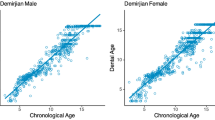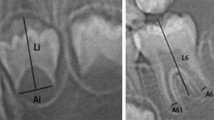Abstract
Age estimation is of prime significance in forensic science and clinical dentistry. Age estimation based on teeth improvement is one solid approach. Numerous radiographic strategies are proposed on the southern populace for evaluating Dental Age (DA), and a comparative appraisal was observed to be insufficient in Indian populace. Henceforth, this investigation goes for detailing a classification model for DA estimation in Indian kid’s populace utilizing Demirjian’s technique. In this exploration, a Fuzzy Neural Network with Teaching Learning - Based Optimization (FNN-TLBO) is proposed for classification of DA. At first, the OPG input image is preprocessed for diminishing noise and smoothing the image by utilizing Anisotropic Diffusion Filter (ADF). Thusly, the whole teeth from teeth picture are portioned utilizing Active Contour Model (ACM) with Analytic Hierarchy Process (AHP) optimization and after that morphological post handling has been connected on the sectioned outcome to advance the order precision. Next, specific highlights are removed, for example, GLCM, Haralick features, Haufsdroff distance, crown and root, tooth density, size, Geometric features such as roughness, concavity, convexity, area and perimeter to upgrade the expectation exactness. Finally, the age has been classified with FNN-TLBO. In this FNN, TLBO is utilized to take care of the system training issue. Recreation results shows that the expected FNN-TLBO procures better execution with deference than accuracy rate of 89%, specificity rate of 89.12%, precision rate of 64.152%, recall rate of 92% and F-measure rate of 71.12% compared than exist algorithms like Modified Extreme Learning Machine with Sparse Representation Classification (MELM-SRC), Radial Basis Function Network (RBFN), Demirjian and Adaptive Neuro Fuzzy Inference System (ANFIS) schemes.










Similar content being viewed by others
References
Aka PS, Canturk N, Dagalp R, Yagan M (2009) Age determination from central incisors of fetuses and infants. Forensic Sci Int 184(1):15–20
Altan HO, Altan A, Bilgiç F, Sözer ÖA, Damlar İ (2016) The applicability of Willems’ method for age estimation in southern Turkish children: a preliminary study. J Forensic Legal Med 38:24–27
Amini, A. A., Weymouth, T. E., & Jain, R. C. (1990). Using dynamic programming for solving variational problems in vision. IEEE Transactions on pattern analysis and machine intelligence, 12(9), 855-867.
Bunyarit SS, Jayaraman J, Naidu MK, Yuen YR, Danaee M, Nambiar P (2017) Modified method of dental age estimation of Malay juveniles. Leg Med (Tokyo) 28:45
Cameriere R, Flores-Mir C, Mauricio F, Ferrante L (2007) Effects of nutrition on timing of mineralization in teeth in a Peruvian sample by the Cameriere and Demirjian methods. Ann Hum Biol 34(5):547–556
Cantekin K, Ercan Sekerci A, Peduk K, Delikan E, Ozakar Ilday N, Demirbuga S et al (2014) Dental age assessment for different climatic regions. Am J Forensic Med Pathol 35(3):197e200
Celik S, Zeren C, Celikel A, Yengil E, Altan A (2014) Applicability of the Demirjian method for dental assessment of southern Turkish children. J Forensic Legal Med 25:1–5
Crespinsek M, Liu SH, Mernik L (2012) A note on teaching-learning-based optimization algorithm. Inf Sci 212:79–93
Demirjian A, Goldstein H, Tanner J (1973) A new system of dental age assessment. Hum Biol:211–227
Demirjian A, Buschang PH, Tanguay R, Patterson DK (1985) Interrelationships among measures of somatic, skeletal, dental, and sexual maturity. Am J Orthod 88(5):433–438
Fantasia E, Rodi G, D’emidio M, Lombardelli E, Padalino G (2016) Comparison between Nolla and Demirjian dental age assessment methods: a systematic review. Webmed Central Orthodont 7(10):1–7
Gabrys B, Burgiela A (2000) General fuzzy min-max neural network for clustering and classification. IEEE Trans Neural Netw 11(3):769–783
Haavikko, K. (1970). The formation and the alveolar and clinical eruption of the permanent teeth. An orthopantomograhic study. Suom Hammaslaak Toim, 66, 101-112.
Kapoor, A. K., Thakur, S., Singhal, P., Chauhan, D., & Jayam, C. (2017). Compare, evaluate, and estimate chronological age with dental age and skeletal age in 6–14-year-old Himachali children. International Journal of Health & Allied Sciences, 6(3), 143.
Kihara EN, Gichangi P, Liversidge HM, Butt F, Gikenye G (2017) Dental age estimation in a group of Kenyan children using Willems’ method: a radiographic study. Ann Hum Biol:1–8
Kumaresan R, Cugati N, Chandrasekaran B, Karthikeyan P (2016) Reliability and validity of five radiographic dental-age estimation methods in a population of Malaysian children. J Investig Clin Dent 7(1):102–109
Kvaal SI, Kolltveit KM, Thomsen IO, Solheim T (1995) Age estimation of adults from dental radiographs. Forensic Sci Int 74(3):175–185
Lam KM, Yan H (1994) Fast greedy algorithm for active contours. Electron Lett 30:21–23
Lee, H. M., Chen, C. M., Chen, J. M., & Jou, Y. L. (2001). An efficient fuzzy classifier with feature selection based on fuzzy entropy. IEEE Transactions on Systems, Man, and Cybernetics, Part B (Cybernetics), 31(3), 426-432.
Lysell L, Magnusson B, Thilander B (1962) Time and order of eruption of the primary teeth. Odontol Revy 13(3):217–235
Machado MA, Daruge E, Fernandes MM, Lima IFP, Cericato GO, Franco A, Paranhos LR (2017) Effectiveness of three age estimation methods based on dental and skeletal development in a sample of young Brazilians. Arch Oral Biol
Martrille L, Ubelaker DH, Cattaneo C, Seguret F, Tremblay M, Baccino E (2007) Comparison of four skeletal methods for the estimation of age at death on white and black adults. J Forensic Sci 52(2):302–307
Moorrees CF, Fanning EA, Hunt EE (1963) Formation and resorption of three deciduous teeth in children. Am J Phys Anthropol 21(2):205–213
Nolla CM 1952 The development of permanent teeth. University of Michigan
Rai, B., & Anand, S. C. (2006). Tooth developments: an accuracy of age estimation of radiographic methods. World J Med Sci, 1(2), 130-132.
Rao RV, Savsani VJ, Vakharia DP (2011) Teaching–learning-based optimization: a novel method forconstrained mechanical design optimization problems. Comput Aided Des 43:303–315
Rao RV, Savsani VJ, Vakharia DP (2012) Teaching-learning-based optimization: an optimization method for continuous non-linear large scale problems. Inf Sci 183:1–15
Rath H, Rath R, Mahapatra S, Debta T (2017) Assessment of Demirjian’s 8-teeth technique of age estimation and Indian-specific formulas in an east Indian population: a cross-sectional study. J Forensic Dent Sci 9(1):45
Reppien K, Sejrsen B, Lynnerup N (2006) Evaluation of post-mortem estimated dental age versus real age: a retrospective 21-year survey. Forensic Sci Int 159(Suppl 1):S84–S88
Rossovskii LE (2017) Image filtering with the use of anisotropic diffusion. Comput Math Math Phys 57(3):401–408
Schmoldt DL et al (2001) The analytic Heirarchy process in natural resource and environmental decision making. Kluwer Academic Publishers, Dordrecht
Sehrawat JS, Singh M (2017) Willems method of dental age estimation in children: a systematic review and meta-analysis. J Forensic Legal Med 52:122–129
Sehrawat JS, Singh M, Sharma V (2016) Forensic dental age estimation of sub-adult individuals using Nolla’s Radiographic method: a systematic review and meta-analysis. Brazilian Journal of Forensic Sciences, Medical Law and Bioethics 6(1):32–46
Tunc ES, Koyuturk AE (2008) Dental age assessment using Demirjian’s method on northern Turkish children. Forensic Sci Int 175(1):23–26
Willems G (2001) A review of the most commonly used dental age estimation techniques. J Forensic Odontostomatol 19(1):9–17
Willems G, Van Olmen A, Spiessens B, Carels C (2001) Dental age estimation in Belgian children: Demirjian's technique revisited. J Forensic Sci 46(4):893–895
Author information
Authors and Affiliations
Corresponding author
Additional information
Publisher’s Note
Springer Nature remains neutral with regard to jurisdictional claims in published maps and institutional affiliations.
Rights and permissions
About this article
Cite this article
B, H., N, R. A versatile approach for dental age estimation using fuzzy neural network with teaching learning - based optimization classification. Multimed Tools Appl 79, 3645–3665 (2020). https://doi.org/10.1007/s11042-018-6434-2
Received:
Revised:
Accepted:
Published:
Issue Date:
DOI: https://doi.org/10.1007/s11042-018-6434-2
Keywords
- Dental age (DA)
- Anisotropic diffusion filter (ADF)
- Active contour model (ACM)
- Analytic hierarchy process (AHP
- Fuzzy neural network (FNN)
- Teaching learning-based optimization (TLBO)
- Modified extreme learning machine (MELM)
- Sparse representation classification (SRC)
- Radial basis function network (RBFN)
- Adaptive neuro fuzzy inference system (ANFIS)




